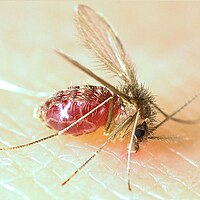
Photo from wikipedia
Local anomalies in rainfall and temperature induced by El Niño and La Niña episodes could change the structure of the vector community. We aimed to estimate the effect of the… Click to show full abstract
Local anomalies in rainfall and temperature induced by El Niño and La Niña episodes could change the structure of the vector community. We aimed to estimate the effect of the El Niño–La Niña cycle in the potential distribution of cutaneous leishmaniasis (CL) vector species in Colombia and to compare the richness of the vectors with the occurrence of CL in the state of Norte de Santander. The potential distributions of four species were modeled using a MaxEnt algorithm for the following episodes: La Niña 2010–2011, Neutral 2012–2015 and El Niño 2015–2016. The relationship between the potential richness of the vectors and the occurrence of CL in Norte de Santander was evaluated with a log-binomial regression model. During the El Niño 2015–2016 episode, Lutzomyia ovallesi and Lutzomyia panamensis increased their distribution into environmentally suitable areas, and three vector species (Lutzomyia gomezi, Lutzomyia ovallesi and Lutzomyia panamensis) showed increases in the range of their altitudinal distribution. During the La Niña 2010–2011 episode, a reduction was observed in the area suitable for occupation by Lutzomyia gomezi and Lutzomyia spinicrassa. During the El Niño 2015–2016 episode, the occurrence of at least one CL case was related to a higher percentage of rural localities showing a richness of vectors = 4. The anomalies in rainfall and temperature induced by the episodes produced changes in the potential distribution of CL vectors in Colombia. In Norte de Santander, during Neutral 2012–2015 and El Niño 2015–2016 episodes, a higher probability of at least one CL case was related to a higher percentage of areas with a greater richness of vectors. The results help clarify the effect of the El Niño–La Niña cycle in the dynamics of CL in Colombia and emphasize the need to monitor climate variability to improve the prediction of new cases.
Journal Title: PLoS Neglected Tropical Diseases
Year Published: 2020
Link to full text (if available)
Share on Social Media: Sign Up to like & get
recommendations!